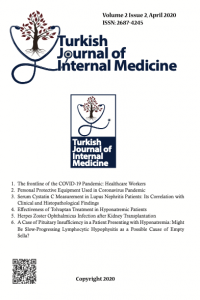Abstract
Cases of pneumonia of unknown etiology in Wuhan, China's Hubei province, was reported to the China country Office of the World Health Organization (WHO) on December 31, 2019. The causative agent was identified as a new coronavirus (2019-nCoV) on January 7, 2020, and the causative agent was identified as a new coronavirus (2019-nCoV) that has not previously been detected in humans. Later, the name of the 2019-nCoV disease was accepted as COVID-19, and the virus was named as SARS-CoV-2 due to its similarity to SARS CoV.1-3
During the SARS-CoV-2 pandemic period, special attention should be paid to personal protective equipment (PPE). Medical staff protection is particularly important because of the risk of infecting other medical team members, not only doctors, nurses, or paramedics but also other support staff necessary to ensure continuity of care for patients.
Keywords
References
- 1. https://www.who.int/emergencies/diseases/novel-coronavirus-2019/events-as-they-happen.
- 2. Andersen K.G., Rambaut A., Lipkin W.I., et al: The proximal origin of SARS-CoV-2. Nat Med 2020; 26: pp. 450-2.
- 3. T.C. Sağlık Bakanlığı COVID 2019SARS-CoV-2 Enfeksiyonu Rehberi. Bilimsel Kurulm Çalışması. 14.04.2020 . 4. Wax R.S., and Christian M.D.: Practical recommendations for critical care and anesthesiology teams caring for novel coronavirus (2019-nCoV) patients. Can J Anaesth 2020.
- 5. Smereka J., and Szarpak L.: COVID 19, a challenge for emergency medicine and every health care professional. Am J Emerg Med 2020 Mar 24.
- 6. Covıd-19 hastalığına yönelik sağlık kuruluşu, personel ve faaliyet türüne göre kullanılması önerilen koruyucu ekipmanlar. T.C Sağlık Bakanlığı Halk Sağlığı Başkanlığı dokümanı.
- 7. https://www.cdc.gov/infectioncontrol/pdf/guidelines/isolation-guidelines-H.pdf.
- 8. https://www.who.int/news-room/commentaries/detail/modes-of-transmission-of-virus-causing-covid-19-implications-for-ipc-precaution-recommendations.
Abstract
References
- 1. https://www.who.int/emergencies/diseases/novel-coronavirus-2019/events-as-they-happen.
- 2. Andersen K.G., Rambaut A., Lipkin W.I., et al: The proximal origin of SARS-CoV-2. Nat Med 2020; 26: pp. 450-2.
- 3. T.C. Sağlık Bakanlığı COVID 2019SARS-CoV-2 Enfeksiyonu Rehberi. Bilimsel Kurulm Çalışması. 14.04.2020 . 4. Wax R.S., and Christian M.D.: Practical recommendations for critical care and anesthesiology teams caring for novel coronavirus (2019-nCoV) patients. Can J Anaesth 2020.
- 5. Smereka J., and Szarpak L.: COVID 19, a challenge for emergency medicine and every health care professional. Am J Emerg Med 2020 Mar 24.
- 6. Covıd-19 hastalığına yönelik sağlık kuruluşu, personel ve faaliyet türüne göre kullanılması önerilen koruyucu ekipmanlar. T.C Sağlık Bakanlığı Halk Sağlığı Başkanlığı dokümanı.
- 7. https://www.cdc.gov/infectioncontrol/pdf/guidelines/isolation-guidelines-H.pdf.
- 8. https://www.who.int/news-room/commentaries/detail/modes-of-transmission-of-virus-causing-covid-19-implications-for-ipc-precaution-recommendations.
Details
| Primary Language | English |
|---|---|
| Subjects | Internal Diseases |
| Journal Section | Reviews |
| Authors | |
| Publication Date | April 29, 2020 |
| Submission Date | April 24, 2020 |
| Acceptance Date | April 25, 2020 |
| Published in Issue | Year 2020 Volume: 2 Issue: 2 |



